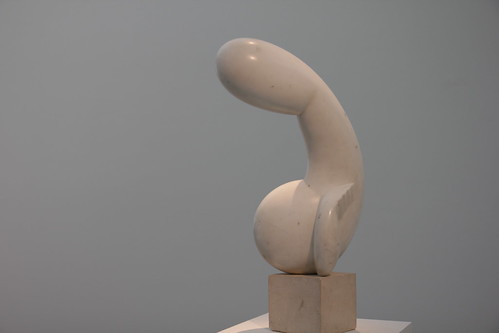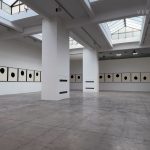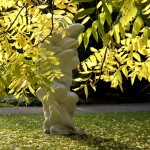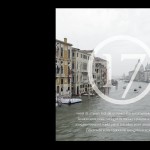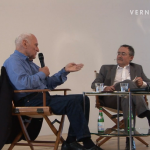Constantin Brancusi & Richard Serra at Fondation Beyeler in Riehen, Switzerland, brings together two of the most important sculptors of the 20th century. Both the oeuvre of Constantin Brancusi and the work of Richard Serra are shown in a comprehensive exhibition.
Constantin Brancusi’s work is represented by about 40 exemplary pieces, which are arranged in various thematic groupings. On display are different variants of “The Kiss”, “Children’s Heads”, “Sleeping Muses”, female torsos, and the “Birds in Space”, “Princess X”, “Adam and Eve”, and “Endless Column”.
The Fondation Beyeler selected ten different works from Richard Serra, among them are early pieces in rubber and lead, the steel sculpture “Strike: To Roberta and Rudy”, and the works “Olson” and Fernando Pessoa”.
The exhibition was curated by Oliver Wick, and conceived in collaboration with the Guggenheim Museum Bilbao, which will present the exhibition from October 10, 2011. The exhibition at Fondation Beyeler runs through August 21, 2011.
Constantin Brancusi and Richard Serra at Fondation Beyeler, Riehen / Switzerland. Vernissage, May 21, 2011.
PS: On May 22, 2011, VernissageTV documented an artist talk with Richard Serra (with Martin Schwander). The video is available here.
> Right-click (Mac: ctrl-click) this link to download Quicktime video file.
Press release:
The Fondation Beyeler is devoting its large summer exhibition to the art of Constantin Brancusi (1876-1957) and Richard Serra (b. 1939), two of the most important sculptors of the twentieth century. Brancusi, born in Romania and a resident of Paris from 1904 onwards, reduced forms to the essentials and thus set the cornerstone for abstract sculpture. The American artist Serra redefined the effects of sculpture by means of minimalistic steel pieces which draw the viewer directly into the work. The phenomenon and presence of sculptural form in space are his prime theme. Taken together, the oeuvres of these two pioneers of European and American sculpture cover the period of over one hundred years in which modern sculpture developed.
The essential aspects of Brancusi’s work are illuminated by about 40 exemplary pieces, arranged in the exhibition in various thematic groupings. The selection covers an oeuvre that extends over forty years of Brancusi’s mature work, revolving around the question of reduction of volumes in space and their transcendence in light – an exploration of formal essence and “primal” form, as it were. The sculptor’s concentrated, lifelong concerns are reflected in a small range of sculptural motifs.
Among the ensembles of works on view are different variants of the monolithic piece The Kiss, the poetic Children’s Heads, Sleeping Muses, female torsos, and the renowned Birds in Space, as well as the scandal-triggering Princess X, Adam and Eve, or the iconic Endless Column. In addition, Brancusi’s The Child in the World, a so-called “mobile group”, has been reconstructed out of the original wooden sculptures. In this form of presentation, Brancusi’s pieces condense into what amounts almost to a retrospective in its own right. Special emphasis is placed on the concept of variation and the experience of the different effects of various materials; to this end, marble and bronze pieces are supplemented in the exhibition by a number in wood, cement and plaster. Precisely a play with material qualities, their different surfaces and reflection or absorption of light, are characteristic traits of Brancusi’s search for an artistic ideal. The sculpture groupings are arranged in separate rooms with ample space around them, in order to make their appearance in space perceptible to viewers as an absolute quality. Also, a photo cabinet contains a selection of twenty original photographs that provide insight into Brancusi’s own personal view of his art.
The crucial recognition of an ideal presence in space, the question as to the essence of sculpture, is approached in a different if not less compelling way in ten sculptural works from different phases of Serra’s oeuvre. In addition, a new series of works on paper is on display. The selection of works, again arranged retrospectively, extends from Serra’s early pieces in rubber and lead, such as the Belts, 1966-67, and Lead Props, as well as his characteristic steel sculpture Strike: To Roberta and Rudy 1969-71 and Delineator (1974/75). The “curved piece” Olson, 1986, opens up another facet of Serra’s work. Fernando Pessoa’s, 2007-08, radical reduction stands for developments of recent years and simultaneously delineates an arc back to earlier works like Strike.
Serra himself has repeatedly emphasized his special interest in Brancusi, whose art he was able to study in Brancusi’s reconstructed studio during an extended stay in Paris in 1964/1965. Every day Serra made a series of drawings that gave him access to the logic of his predecessor’s work and enabled him to draw lessons from his sculptural thinking. Later, Serra would even describe Brancusi’s art as an “encyclopedia”, a “handbook of possibilities,” if one that inspired him to quite different sculptural conclusions. In the exhibition, the aesthetic relationships between Brancusi and Serra are visualized in the form of an open-ended, free dialogue between their works – direct juxtapositions that reveal both traits shared in common and striking contrasts alternate with suites of works that reflect the universal force of sculpture and show it in a new light. Especially sculptural volumes that rest in time and space, and simultaneously maintain a precarious equilibrium, link Brancusi and Serra’s singular oeuvres and point to the universality and continuity of sculpture in general.
Brancusi’s sculptural work is on view for the first time in Switzerland in retrospective form. Nor has Serra’s oeuvre previously been represented here so extensively. The installation of Serra’s sculptures at the Fondation Beyeler was an enormous technical challenge, as the static conditions had first to be established. For the installation of Fernando Pessoa alone, about seventy tons of steel, including the sculpture’s weight, had to be moved.
The loans to the exhibition stem from renowned private collections and public museums, including the Solomon R. Guggenheim Museum, New York; the Museum of Modern Art, New York; the Museum of Fine Arts, Houston; the Philadelphia Museum of Art; the Art Gallery of Ontario, Toronto; the Tate, London; the Musée National d’Art moderne, Centre Georges Pompidou, Paris; the Peggy Guggenheim Collection, Venice; the Stedelijk Museum, Amsterdam; the Muzeul de ArtÇŽ, Craiova; the Hamburger Kunsthalle; the Staatsgalerie Stuttgart; the Lehmbruck Museum, Duisburg; the Kunstmuseum Basel, and the Kunsthaus Zurich.
Curated by Oliver Wick, the Fondation Beyeler exhibition was conceived in collaboration with the Guggenheim Museum Bilbao, which is foreseen as the next venue (October 10, 2011 – April 15, 2012).
The exhibition is accompanied by an abundantly illustrated scholarly catalogue, published in separate German, English and Spanish editions by Hatje Cantz Verlag, Ostfildern. It contains essays by Oliver Wick, Friedrich Teja Bach, Alfred Pacquement, and Jacqueline Matisse Monnier, and commentaries by Raphaël Bouvier, Denise Ellenberger, Alexandra Parigoris, Ileana Parvu, Marielle Tabart, Michelle White, and Jon Wood, and biographies of the two artists. 244 pages, 176 illustrations, CHF 68, ISBN 978-3-905632-89-7.
Richard Serra is represented by three outdoor sculptures in Basel and environs: Open Field Vertical / Horizontal Elevations at Wenken Park in Riehen/Basel, installed in 1980 in the context of “Sculpture in the 20th Century,” co-organized by Ernst Beyeler; the steel sculpture Intersection, installed in 1992 on Theaterplatz in Basel city center; and Dirk’s Pod, a steel piece unveiled in 2004 on the Novartis Campus, Basel.
